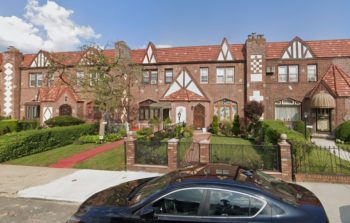
Houses along 222nd Street in the proposed Cambria Heights-222nd Street Historic District. Image Credit: Google Maps.
Residents raised concerns about the cost and difficulty in maintaining special details and features. On September 14, 2021, the Landmarks Preservation Commission held a public hearing for two proposed historic districts in Cambria Heights, Queens. The Cambria Heights-222nd Street Historic District and the Cambria Heights-227th Street Historic District are both well-preserved examples of the Tudor Revival and Storybook styles and of the 1930s suburban expansion in Queens.
The Cambria Heights – 222nd Street Historic District consists of 46 Tudor Revival row houses from 115-59 222nd Street to 115-104 222nd Street between 115th Road and 116th Avenue. The Cambria Heights – 227th Street Historic District features 50 Tudor Revival row houses along both sides of 227th Street between 116th Avenue and Lindon Boulevard. The historic district features the addresses from 116-01 227th Street to 116-50 227th Street. The houses in both districts were constructed between 1931-1932.
Both districts feature Tudor Revival style houses that feature “Storybook” style elements that showcase a fairytale or move-set like aesthetic. While the first residents of Cambria Heights were white middle class families, the neighborhood grew as a prominent area for black homeownership. For CityLand’s prior coverage of the designation process, click here.
At the public hearing, a couple people spoke in support of the designation of the historic districts, and a couple of homeowners raised concerns about the designation.
A representative from Council Member I. Daneek Miller spoke on his behalf in support of the designation of the historic districts, mentioning the two-year process in working with the Landmarks Preservation Commission to survey southeast Queens and identify buildings or possible historic districts for designation to preserve the history of the area. According to the representative, the Council Member only received comments in support of designation from residents within the two proposed districts.
Andrea Goldwyn of the New York Landmarks Conservancy spoke in support of the designation, highlighting the architecture of the districts.
Bill Collins, a resident of one of the blocks, spoke in opposition to the designation, citing a lack of notice prior to the designation process and not wanting control over maintenance or renovation decisions to be given over to a government agency. Mr. Collins also mentioned that some of the building features like shingles and windows are old and would be expensive to replace with original looking features if required by Landmarks.
David Henry, a resident, elaborated on the difficulties in finding supplies and contractors that can do the repair work for the special details and features of the properties within the district. He also raised concerns about grants available for homeowners to make repairs, and what would be grandfathered in. Another homeowner had questions about what the establishment of a historic district means for his property, and Chair Carroll stated that Landmarks staff would reach out to work with him and answer his questions.
Landmarks will vote on designation at a later date.
By: Veronica Rose (Veronica is the CityLaw fellow and a New York Law School graduate, Class of 2018.)

